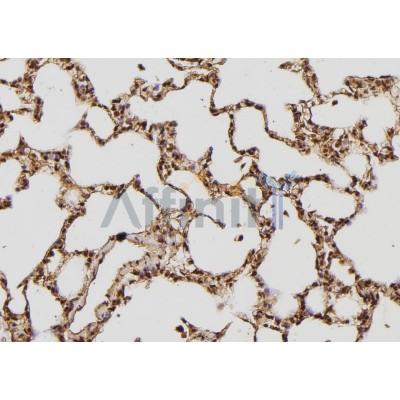AMPK beta 1 Antibody - #AF6494
| Product: | AMPK beta 1 Antibody |
| Catalog: | AF6494 |
| Description: | Rabbit polyclonal antibody to AMPK beta 1 |
| Application: | WB IHC IF/ICC |
| Reactivity: | Human, Mouse, Rat, Monkey |
| Prediction: | Bovine, Horse, Sheep, Rabbit, Dog, Chicken |
| Mol.Wt.: | 38kDa; 30kD(Calculated). |
| Uniprot: | Q9Y478 |
| RRID: | AB_2835305 |
Product Info
*The optimal dilutions should be determined by the end user. For optimal experimental results, antibody reuse is not recommended.
*Tips:
WB: For western blot detection of denatured protein samples. IHC: For immunohistochemical detection of paraffin sections (IHC-p) or frozen sections (IHC-f) of tissue samples. IF/ICC: For immunofluorescence detection of cell samples. ELISA(peptide): For ELISA detection of antigenic peptide.
Cite Format: Affinity Biosciences Cat# AF6494, RRID:AB_2835305.
Fold/Unfold
1300015D22Rik; 5''-AMP-activated protein kinase subunit beta-1; 5'-AMP-activated protein kinase beta-1 subunit; AAKB1_HUMAN; AMP-activated protein kinase beta subunit; AMP-ACTIVATED PROTEIN KINASE, NONCATALYTIC, BETA-1; AMP-activated, noncatalytic, beta-1; AMPK; AMPK beta 1 chain; AMPK subunit beta-1; AMPK-BETA-1; AMPKb; AU021155; E430008F22; HAMPKb; MGC17785; PRKAB1; Protein kinase AMP activated non catalytic subunit beta 1; protein kinase, AMP-activated, beta 1 non-catalytic subunit; protein kinase, AMP-activated, noncatalytic, beta-1;
Immunogens
A synthesized peptide derived from human AMPK beta 1, corresponding to a region within the internal amino acids.
- Q9Y478 AAKB1_HUMAN:
- Protein BLAST With
- NCBI/
- ExPASy/
- Uniprot
MGNTSSERAALERHGGHKTPRRDSSGGTKDGDRPKILMDSPEDADLFHSEEIKAPEKEEFLAWQHDLEVNDKAPAQARPTVFRWTGGGKEVYLSGSFNNWSKLPLTRSHNNFVAILDLPEGEHQYKFFVDGQWTHDPSEPIVTSQLGTVNNIIQVKKTDFEVFDALMVDSQKCSDVSELSSSPPGPYHQEPYVCKPEERFRAPPILPPHLLQVILNKDTGISCDPALLPEPNHVMLNHLYALSIKDGVMVLSATHRYKKKYVTTLLYKPI
Predictions
Score>80(red) has high confidence and is suggested to be used for WB detection. *The prediction model is mainly based on the alignment of immunogen sequences, the results are for reference only, not as the basis of quality assurance.
High(score>80) Medium(80>score>50) Low(score<50) No confidence
Research Backgrounds
Non-catalytic subunit of AMP-activated protein kinase (AMPK), an energy sensor protein kinase that plays a key role in regulating cellular energy metabolism. In response to reduction of intracellular ATP levels, AMPK activates energy-producing pathways and inhibits energy-consuming processes: inhibits protein, carbohydrate and lipid biosynthesis, as well as cell growth and proliferation. AMPK acts via direct phosphorylation of metabolic enzymes, and by longer-term effects via phosphorylation of transcription regulators. Also acts as a regulator of cellular polarity by remodeling the actin cytoskeleton; probably by indirectly activating myosin. Beta non-catalytic subunit acts as a scaffold on which the AMPK complex assembles, via its C-terminus that bridges alpha (PRKAA1 or PRKAA2) and gamma subunits (PRKAG1, PRKAG2 or PRKAG3).
Phosphorylated when associated with the catalytic subunit (PRKAA1 or PRKAA2). Phosphorylated by ULK1; leading to negatively regulate AMPK activity and suggesting the existence of a regulatory feedback loop between ULK1 and AMPK.
The glycogen-binding domain may target AMPK to glycogen so that other factors like glycogen-bound debranching enzyme or protein phosphatases can directly affect AMPK activity.
Belongs to the 5'-AMP-activated protein kinase beta subunit family.
Research Fields
· Cellular Processes > Cellular community - eukaryotes > Tight junction. (View pathway)
· Environmental Information Processing > Signal transduction > FoxO signaling pathway. (View pathway)
· Environmental Information Processing > Signal transduction > AMPK signaling pathway. (View pathway)
· Environmental Information Processing > Signal transduction > Apelin signaling pathway. (View pathway)
· Human Diseases > Endocrine and metabolic diseases > Insulin resistance.
· Human Diseases > Endocrine and metabolic diseases > Non-alcoholic fatty liver disease (NAFLD).
· Human Diseases > Cardiovascular diseases > Hypertrophic cardiomyopathy (HCM).
· Organismal Systems > Aging > Longevity regulating pathway. (View pathway)
· Organismal Systems > Aging > Longevity regulating pathway - multiple species. (View pathway)
· Organismal Systems > Environmental adaptation > Circadian rhythm. (View pathway)
· Organismal Systems > Endocrine system > Insulin signaling pathway. (View pathway)
· Organismal Systems > Endocrine system > Adipocytokine signaling pathway.
· Organismal Systems > Endocrine system > Oxytocin signaling pathway.
· Organismal Systems > Endocrine system > Glucagon signaling pathway.
Restrictive clause
Affinity Biosciences tests all products strictly. Citations are provided as a resource for additional applications that have not been validated by Affinity Biosciences. Please choose the appropriate format for each application and consult Materials and Methods sections for additional details about the use of any product in these publications.
For Research Use Only.
Not for use in diagnostic or therapeutic procedures. Not for resale. Not for distribution without written consent. Affinity Biosciences will not be held responsible for patent infringement or other violations that may occur with the use of our products. Affinity Biosciences, Affinity Biosciences Logo and all other trademarks are the property of Affinity Biosciences LTD.

